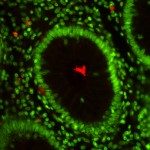Lien vers Pubmed [PMID] – 7476198
Mol. Microbiol. 1995 Jul;17(1):123-35
In addition to Ipa proteins and IcsA, which are involved in entry into epithelial cells and intercellular spread, respectively, Shigella secretes a 110 kDa protein, designated SepA. We report the identification, cloning, and nucleotide sequence determination of the sepA gene, analysis of SepA secretion, and construction and characterization of a sepA mutant. The sepA gene is carried by the virulence plasmid and codes for a 150 kDa precursor. Upon secretion, which does not involve accessory proteins encoded by the virulence plasmid, the precursor is converted to a mature protein of 110 kDa by two cleavages removing an N-terminal signal sequence and a C-terminal fragment. Extensive similarities were detected between the sequence of the first 500 residues of mature SepA and the N-terminal region of IgA1 proteases from Neisseria gonorrhoeae and Haemophilus influenzae, the Tsh haemagglutinin of an avian pathogenic Escherichia coli, and the Hap protein involved in adhesion and penetration of H. influenzae. The C-terminal domain of the SepA precursor, which is not present in the secreted protein, exhibits sequence similarity with pertactin of Bordetella pertussis and the ring-forming protein of Helicobacter mustelae. Construction and phenotypic characterization of a sepA mutant indicated that SepA is required neither for entry into cultured epithelial cells nor for intercellular dissemination. However, in the rabbit ligated ileal loop model, the sepA mutant exhibited an attenuated virulence, which suggests that SepA might play a role in tissue invasion.

